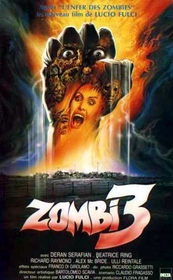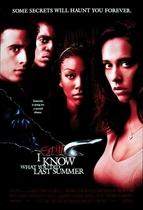Our editor-in-chief Nate Yapp is proud to have contributed to the new book Hidden Horror: A Celebration of 101 Underrated and Overlooked Fright Flicks, edited by Aaron Christensen. Another contributors include Anthony Timpone, B.J. Colangelo, Dave Alexander, Classic-Horror.com's own Robert C. Ring and John W. Bowen. Pick up a copy today from Amazon.com!
Zombi 3 (1988)
Of the dozens of zombie films I have seen, from George A. Romero’s seminal Night of the Living Dead to Danny Boyle’s revisionist 28 Days Later, Zombi 3 is one of them. Far more notable for the stories behind its making than any quality it might possess, Zombi 3 isn’t exactly a waste of time if you approach it correctly. As a window into a particular period of Italian horror film production, it’s kind of fascinating, but as entertainment, it stinks like rotting flesh.
In the Philippines, a zombie-making chemical known as Death One is release into the atmosphere by the severe bungling of both a terrorist group and the military. As most of the population succumbs to a bad case of the undeads, several survivors hole up in an abandoned hotel. Eventually, they decide to work their way toward the local military base, facing zombies and an armed disease containment force along the way.
Not only is the premise uninspired and without innovations – you can see the hijacked DNA of Night of the Living Dead, The Crazies, and Return of the Living Dead – Zombi 3 also suffers from too many cooks in the kitchen. Reportedly, credited director Lucio Fulci flew down to the Phillipines and, possibly because he was quite ill and wanted to speed up the shoot, jettisoned a good chunk of the script by Claudio Fragasso and an uncredited Rossella Drudi. Fulci’s finished film was 70 minutes – 50 after it was further edited to correct the pacing problems. Bruno Mattei, who was in the Phillipines making Robowar at the time, stepped up, hired new actors, and filmed an entire secondary plotline that wrapped around Fulci’s footage.
The result is an incredibly disjointed film, with one film laid on top of the other. From a narrative standpoint, Mattei's segments do fit with Fulci's, roughly speaking, but no steps were taken to match their visual quality. You can always tell which parts are Mattei's, because they're flatly lit, with unseemly glares that should have been caught and fixed before the camera ever rolled. Except when Mattei switches to (surprisingly effective) handheld shots, his scenes lack any sense of visual depth (and dramatic depth, but that's another matter entirely). He can't seem to rein in his actors, either, since he allows Robert Marius (playing a concerned scientist) to flail his limbs about and slam clipboards in Very Dramatic Ways. However, I have to give Mattei credit for meeting the bare minimum requirements of the job he was given. I can't imagine trying to fit an entire plotline around someone else's already completed film is easy and, in interviews, Mattei is always quick to note that he considers Zombi 3 to be Fulci's film. As such, I'm not going to further rip apart Mattei's contributions, although I have ample opportunity to do so.
With Mattei out of the way, we turn now to Fulci. Where you can recognize Mattei's sections by their hasty construction and poor cinematography, you can identify Fulci's by their overall competence in the same areas. Shots are generally properly lit and framed, giving a sense of visual depth and, in the better moments, dread. It's by no means Fulci's best work – he relies far too heavily on fog machines to generate the visual atmosphere of his zombie sequences – but when put against the work of a lesser director, it's easier to appreciate a craftsman's skill, even when he appears to be phoning it in.
Unfortunately for Fulci, it doesn't appear that he had decent writing to work with. Fragasso and Drudi's screenplay is less a narrative and more a series of zombie attack vignettes strung together by a threadbare excuse for a plot. One or two characters will head off to some secluded spot for an entirely lame reason and then run into a whole passel of the undead. Most of the time, nobody makes it out uneaten. If there are any survivors in these vignettes, it is usually because they have demonstrated some ingenuity or fighting skill that doesn't fit with anything we've seen from them previously. For instance, early in the film, Patricia (played by Beatrice Rose) is being chased by zombies out of a gas station. A nearby fuel pump busts open, and our heroine, who has been near-hysterical up to this point, cooly decides to make zombie flambe by tossing her lighter at the gushing spray of petrol. Cue giant explosion. In another moment that is particularly void of human logic, one of the characters (played by actor and stuntman Ottaviano Dell'Acqua) is scouting ahead of the rest of the group and gets attacked by several flesheating nasties. Instead of, say, calling for help, he tells his comrades to stay back. This is not sane behavior. Then, this guy, who has previously shown no real inclination towards hand-to-hand combat, becomes a one-man army of zombie ass-whuppin’, taking on all the undead bastards who come his way with fisticuffs and roundhouse kicks. Clearly, Zombi 3 seems more content to deal with the characters as zombie chow or zombie assassins than as human beings, avoiding unimportant things like recognizable emotions, personal histories, and consistency of actions.
One nice upshot of these brief zombie “happenings”, however, is they provide makeup effects guru Franco Di Girolamo to show off some of his wizardry. Zombies get dispatched in a variety of ways, including one particularly effective moment when one is impaled through the neck. Predating Zack Snyder's Dawn of the Dead remake, a pregnant woman “births” a zombie baby, although much more messily in this instance. Sadly, a flying zombie head effect, although technically well-conceived and executed, falls flat because it doesn't fit with the concept of zombies as victims of infection rather than as a mystical or simply inexplicable occurrence (the same idea would be reused much more effectively in Michele Soavi's existentialist zombie flick, Cemetery Man, six years later).
The most fascinating aspects of Zombi 3, however, can be found on Shriek Show's DVD release. Presented in its original aspect ratio for the first time on North American home video, Zombi 3 looks fine for the most part, although they went a little overboard on edge enhancement (a criticism that can be leveled at most of Shriek Show's releases). Moments are extreme gore are muddy and of a markedly different visual quality than the rest of the film. Apparently, the 35mm print the DVD producers were working with contained an edited version of the film, and they had to splice in the missing frames from the uncut Japanese videotape. The disc's special features are a veritable buffet of informative goodies, including interviews with Mattei, Fragasso, Di Girolamo, Dell'Acqui, and actors Massimo Vanni and Marina Lol. The conversations with Mattie and Fragasso are the most revealing; they put to bed certain rumors that had cropped up around Zombi 3, like that Fulci had only shot 15 minutes worth of the finished product. The commentary with Rose and co-star Deran Sarafian is the best part of the whole disc, because Sarafian has a great mischievous wit. His riff during the first five minutes where he claims he's playing the “hairless Filipino boy” is, by itself, something that makes suffering through the generally underwhelming quality of the film worth the effort.
While I don't frequently talk about the DVD, I did so here because if you do want a lot of interesting historical information on this particular period of Italian exploitation cinema, you'll get it on the Zombi 3 disc. You'll also get a lackluster zombie film started by a director on the downswing and finished by a director who never had an upswing in the first place. I suppose sometimes you just have to take the good with the bad.








